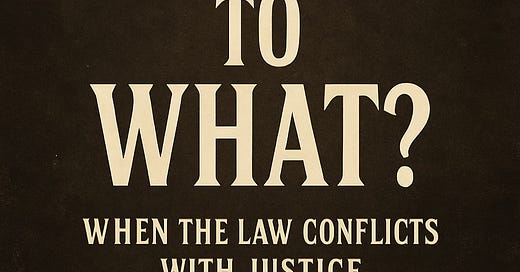CH 9 - Obedience to What? When the Law Conflicts with Justice
From Criminal by Design: The Architecture of Harm in U.S. Immigration
Listen to the podcast
Return to the Criminal by Design: The Architecture of Harm in U.S. Immigration Hub
We’re taught that obedience to the law is a moral good.
That justice comes from order. That morality and legality walk hand in hand.
But what happens when the law becomes a shield for cruelty and a tool for exclusion? What happens when law is no longer a standard of justice—but a strategy for preserving power?
"When the system is unjust, silence isn’t neutrality. And obedience isn’t integrity."
Legality is Not Morality
Laws are written by people in power—and power is not always aligned with justice.
Slavery, segregation, and the denial of women’s rights were all legal.
The internment of Japanese Americans during WWII was legal.
The Indian Removal Act was legal.
Today, policies that criminalize immigrants for seeking safety or opportunity are framed as law and order.
But legality does not equal legitimacy.
"Obeying the law may keep you out of jail. But it won’t always keep you on the right side of history."
Obedience as a System Design
The state does not just expect compliance—it trains us into it.
School drills teach children to be silent, still, and compliant.
Immigration law teaches families to keep their heads down and not speak out.
ICE raids are designed to create terror, not due process.
People obey because they are afraid of what happens if they don’t.
According to Prospect Theory, people fear loss more than they desire gain. The immigration system exploits this psychology:
Obey and maybe survive.
Resist and you risk detention, deportation, family separation, or worse.
“If you want obedience, threaten safety. If you want silence, threaten family.”
What Are We Being Asked to Obey?
Laws that criminalize parents for trying to save their children.
Orders that separate toddlers from mothers.
Agents who lie, show no warrant, break into homes, and disappear people.
Policies that deport people to third countries they’ve never lived in.
Detention facilities that ignore court orders.
These are not hypothetical abuses—they are on record.
"In 2024, multiple ICE units ignored judicial orders, proceeding with deportations of individuals whose cases were still pending." (Source: ACLU)
So we must ask: obedience to what? To whom? And at what cost?
THX Breakdown — When Law Becomes the Weapon
Utilities distorted:
Clarity: The law becomes vague when it suits power
Security: It protects institutions, not individuals
Access: Legal protections are hollow without money or influence
Value: Measured by compliance, not character
PERMAH erosion:
Meaning: Obedience replaces conscience
Accomplishment: Doing the right thing becomes dangerous
Health: The psychological toll of watching injustice sanctioned by law
Admiration Equation collapse:
No Skill in punishing those who need protection
No Goodness in writing laws that criminalize compassion
No Awe in uniformed violence against families
No Gratitude in silence sustained by fear
“You can’t build admiration from a foundation of obedience. Admiration grows from courage.”
Final Reflection and Challenge
Law can be a shield—or a weapon. A path to justice—or a tool of cruelty.
History remembers those who resisted immoral laws—not those who enforced them.
So we must ask, not just what the law says—but whether the law deserves our respect.
"If obedience demands silence in the face of harm, it’s not order. It’s surrender."
Call to Action: Share this. Especially with people who still think the law is always right. Ask: Would you have obeyed in every era? If not, why obey now without question?
NEXT - CH10: Children of the System
The Generational Toll of Immigration Policy
Even U.S. citizens are paying the price—with their childhoods.




